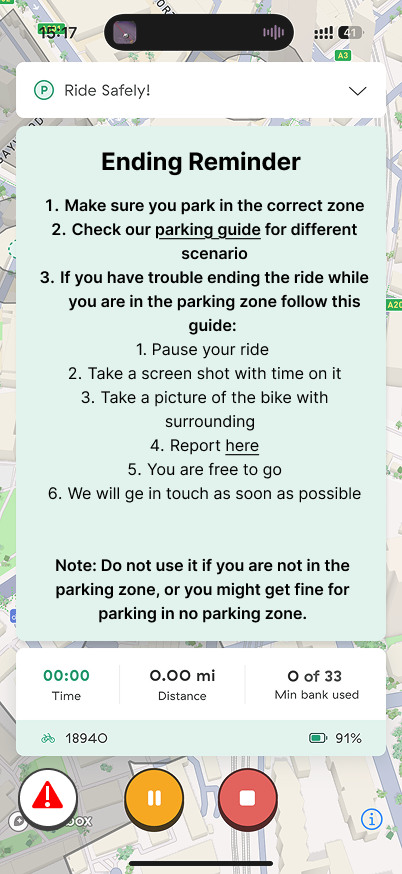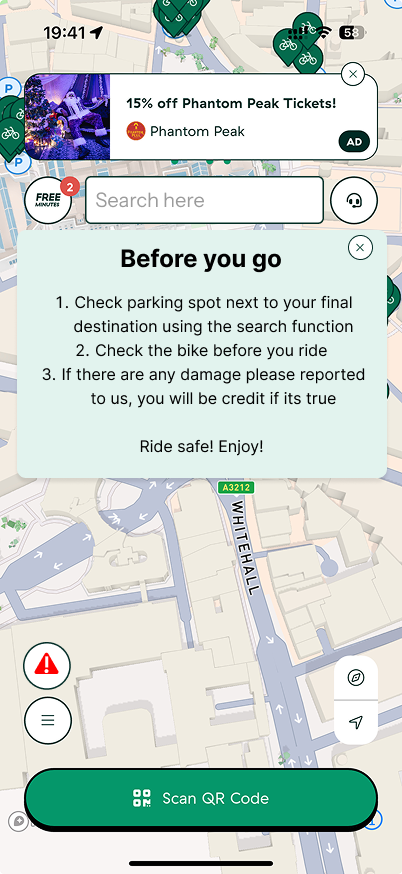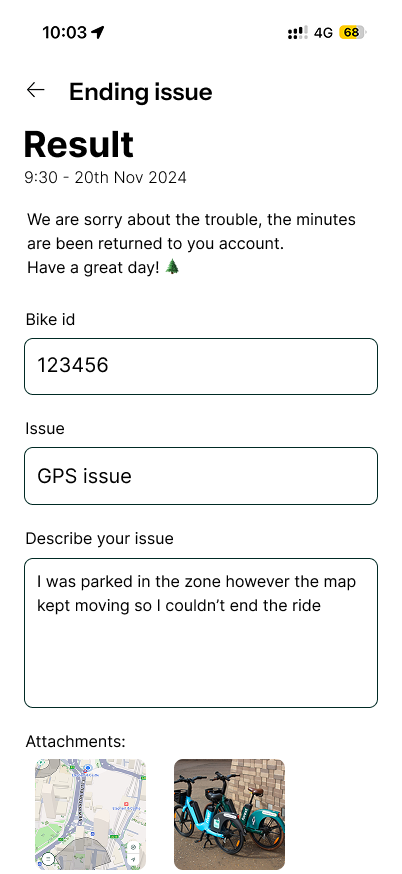Forest Bike UX study
Conducted between 4th - 9th November 2024
*I’m not affiliated with Forest in any capacity, and this case study’s views are strictly my own.
Table of contents
Project background
Research detail
Observation
Insights
Recommendations
Conclusion
Project background
After been user of Forest for more then half a year and observing their iterations, I couldn't help but notice that some small aspects of their service could be smoother.
Hopefully this study will help them improved their service.
Background research on Forest
“The Forest team aim for 90% of their fleet to be available to ride at any time. Damaged bikes need to be assessed, repaired and tested as efficiently as possible.”
“Forest have used a mixed resourcing model where their core team in the workshop is permanent and they supplement it with agency staff when they see increased demand.”
They rely on quick turnaround times for fixing issues and doing most of the work in-house. Therefore, finding the balance between efficiency and better user experience is key for them.
Research detail
Research Goal
Understand how the app perform now based on reviews
To verify the imperfect UX design I noticed with reviews
To identify any issues I may have overlooked that could be causing problems for users while performing tasks.
Research Method
Online reviews
Personal experience
Observation
User reported extra charged and free minutes aren’t free
Having trouble dropping off the bike.
App itself is hard to use and difficult to report problems.
Insights
1. False advertising
Problem 1: Recent changes to free 10 minutes rule
Previously, the free 10 minutes were used first, followed by minutes from the bundle or paid usage.
Now, minutes are used in the order they are received, from oldest to newest. Which means for bundle user they won’t have the free 10 minutes daily.
Problem 2: £1.90 to unlock the bike with 10 minutes free
Users interpret this as not having 10 free minutes.
The £1.90 unlock fee is more expensive than Lime’s £1 unlock fee.
However, the overall 10 minutes still remains cheaper than Lime.
Not a problem, but not helping: Price increase and time reduction on bundles
The price has increased from £25 to £30 for the 400-minute package.
The time has been reduced from 480 minutes to 400 minutes for the same package.
Long-term users are not responding well to these price increases. Most of these users are price-sensitive, and they are reacting negatively to price hikes or getting less value for the same amount of money. Both factors combined are even worse for them.
2. Having issue ending ride
Problem 1: Not checking parking at the ending location
Users may not check their ending location or the parking options around it.
Result to wasted time or users being charged for improper parking.
Problem 2: GPS issue that users might not understand
User are in the parking zone, but the app doesn't allow them to end the ride.
Result to wasted time and frustration.
Problem 3: Internet issue
The app may show the ride as "ending" for an extended period, sometimes without actually ending the ride.
Result to more time and money spent.
Many users are time-sensitive, so a smooth process for getting a bike and ending the ride is key to their experience.
3. Complicated process to report bad behaviour
Problem 1: Support team was helpful, but the process is slow
Users found it difficult and slow to report problems with their ride or poor parking.
It is also a fairly slow process to contact someone if they have issues with ending their ride.
Again, many users are time-sensitive. When issues arise, it's even more important to have a smooth and fast process, especially when people are frustrated.
Recommendation
1. False advertising
Suggestion 1: Be open and clear with users about the reasoning behind the cost increase. Encourage people to park safely and implement a punishment system for those who don’t park properly (especially in areas with empty bays). Provide more guidance on parking in different scenarios (e.g., busy vs. not busy areas). Additionally, make the reporting system easier with minimal user input (e.g., taking a picture and selecting an option in the app).
Advantage: Encourages users to take better care of the bikes when parking.
Advantage: Over time, this leads to better user behaviour.
Disadvantage: Requires more effort from users.
Suggestion 2: With the new minutes system in place, give higher credit to users who report issues. Keep parking photos until the next two rides are completed, which could help determine if the previous user should be fined. Assign maintenance costs to those who cause damage.
Advantage: More users will report problem bikes, and it’s cheaper for good users.
Advantage: Users will be more aware of their behaviour.
Disadvantage: Requires more processing and might increase running costs.
Disadvantage: If most damage occurs during non-usage time, no one will be held accountable (and the damage would be covered by the 90p daily fee).
Suggestion 3: Offer discounts or penalties based on user behaviour. Everyone starts with the base price (current price). As users demonstrate better parking habits, park in designated areas, or report problems, they earn 1-10% discounts on their rides or packages.
Advantage: Retains good users and encourages positive behaviour.
Advantage: Users will be on your side and more likely to help with parking and taking care of bikes, which might save running costs in the long run.
Disadvantage: Mistakes could occur during the process.
Slight disadvantage: More processing is required (could be mitigated with one extra step per process).
Suggestion 4: Stop using the daily 10-minute advertising. Users may feel scammed even if Forest is cheaper than competitors. Instead, highlight the aspects that Forest does better, such as being more convenient than Santander bikes, cheaper than Lime bikes, and faster and more stable than TFL.
Advantage: Users will better understand what they are paying for and feel more satisfied.
Disadvantage: Increased spending on new advertising.
2. Having issue ending ride
Problem 1: Not checking parking at the ending location
Move the search function to the main screen and make it more obvious to users. Also, remind them to check their destination and parking options before ending the ride.
Problem 2: GPS issue that users might not understand
Check with the backend team for any potential performance improvements. Consider adding a buffer zone around the parking area so that users within the zone, experiencing GPS drift, have a better experience.
Using data gathered from reports, you can adjust the buffer zone in specific areas.
Add a quick problem upload system that pauses the ride first and verifies it afterward, so users won't spend too long standing around feeling frustrated. Provide clear instructions on what they need to do.
1. Take screen shot with timestamp
2. Take a photo of the bike
3. Report
4. Pause the bike
5. Get result later
Problem 3: Internet issue
It's unclear what the backend process is for ending a ride. However, I assume the picture needs to be uploaded first before the ride can be ended, which could result in slow ending times or, in the worst case, the ride not ending at all.
Suggestion 1: Improve the backend system for ending rides: Verify the GPS location and pause the ride first, then upload the picture, followed by feedback.
In cases of bad parking or incorrect locations, warnings could be issued the first few times, followed by fines.
Advantage: Faster ending times, especially in areas with poor signal. Less frustrating for users.
Advantage: Helps develop better long-term user behaviour.
Disadvantage: It relies more on users to park properly, but this could be countered by the punishment/discount system.
Disadvantage: If the user closes the app before the picture finishes uploading, it might result in the picture not being uploaded.
Suggestion 2: Provide a reminder for users to check parking before the picture is taken when ending.
Advantage: Gives users more freedom when using the service.
Disadvantage: Bad behaviour may increase, but this could be countered by the punishment/discount system.
Suggestion 3: Send a notification or email with a summary of the previous ride.
Including information on locked bikes, ride cost, etc., if the user closes the app before the picture finishes uploading.
3. Complicated process to report bad behaviour/problem
Suggestion: Similar systems as having ending issues.
Conclusion
Although we've only focused on negative feedback for this study, most of the reviews are generally positive.
For a business that heavily relies on efficiency, finding the right balance between user experience and internal processes is very important. With these thoughts in mind, I believe the suggestions will improve Forest Bike and their service, benefiting both users and the team.











